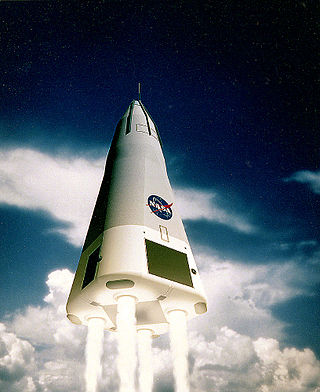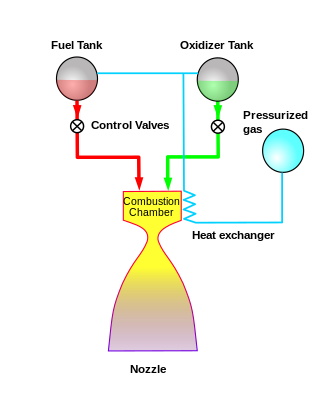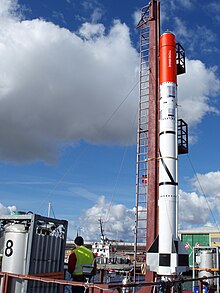
Human spaceflight is spaceflight with a crew or passengers aboard a spacecraft, often with the spacecraft being operated directly by the onboard human crew. Spacecraft can also be remotely operated from ground stations on Earth, or autonomously, without any direct human involvement. People trained for spaceflight are called astronauts, cosmonauts (Russian), or taikonauts (Chinese); and non-professionals are referred to as spaceflight participants or spacefarers.

Project Mercury was the first human spaceflight program of the United States, running from 1958 through 1963. An early highlight of the Space Race, its goal was to put a man into Earth orbit and return him safely, ideally before the Soviet Union. Taken over from the US Air Force by the newly created civilian space agency NASA, it conducted 20 uncrewed developmental flights, and six successful flights by astronauts. The program, which took its name from Roman mythology, cost $2.68 billion. The astronauts were collectively known as the "Mercury Seven", and each spacecraft was given a name ending with a "7" by its pilot.

Energia was a 1980s super-heavy lift launch vehicle. It was designed by NPO Energia of the Soviet Union as part of the Buran program for a variety of payloads including the Buran spacecraft. Control system main developer enterprise was the Khartron NPO "Electropribor". The Energia used four strap-on boosters each powered by a four-chamber RD-170 engine burning kerosene/LOX, and a central core stage with four single-chamber RD-0120 (11D122) engines fueled by liquid hydrogen/LOX.

A hybrid-propellant rocket is a rocket with a rocket motor that uses rocket propellants in two different phases: one solid and the other either gas or liquid. The hybrid rocket concept can be traced back to the early 1930s.

A hypergolic propellant is a rocket propellant combination used in a rocket engine, whose components spontaneously ignite when they come into contact with each other.
Human spaceflight programs have been conducted, started, or planned by multiple countries and companies. Until the 21st century, human spaceflight programs were sponsored exclusively by governments, through either the military or civilian space agencies. With the launch of the privately funded SpaceShipOne in 2004, a new category of human spaceflight programs – commercial human spaceflight – arrived. By the end of 2022, three countries and one private company (SpaceX) had successfully launched humans to Earth orbit, and two private companies had launched humans on a suborbital trajectory.

AS-101 was the sixth flight of the Saturn I launch vehicle, which carried the first boilerplate Apollo spacecraft into low Earth orbit. The test took place on May 28, 1964, lasting for four orbits. The spacecraft and its upper stage completed a total of 54 orbits before reentering the atmosphere and crashing in the Pacific Ocean on June 1, 1964.

The DC-X, short for Delta Clipper or Delta Clipper Experimental, was an uncrewed prototype of a reusable single-stage-to-orbit launch vehicle built by McDonnell Douglas in conjunction with the United States Department of Defense's Strategic Defense Initiative Organization (SDIO) from 1991 to 1993. Starting 1994 until 1995, testing continued through funding of the US civil space agency NASA. In 1996, the DC-X technology was completely transferred to NASA, which upgraded the design for improved performance to create the DC-XA. After a test flight of DC-XA in 1996 resulted in a fire, the project was canceled. Despite its cancellation, the program inspired later reusable launch systems. Michael D. Griffin has since praised the program as "government R&D at its finest."

The pressure-fed engine is a class of rocket engine designs. A separate gas supply, usually helium, pressurizes the propellant tanks to force fuel and oxidizer to the combustion chamber. To maintain adequate flow, the tank pressures must exceed the combustion chamber pressure.
Amateur rocketry, sometimes known as experimental rocketry or amateur experimental rocketry, is a hobby in which participants experiment with fuels and make their own rocket motors, launching a wide variety of types and sizes of rockets. Amateur rocketeers have been responsible for significant research into hybrid rocket motors, and have built and flown a variety of solid, liquid, and hybrid propellant motors.
Danish Space Research Institute (DSRI) was the space agency of Denmark from 1966 to 2005. It was a Danish sector research institute formed in 1966 under the Danish Ministry for Education and Research, later the Danish Ministry of Science Technology and Innovation. Denmark was a founding member of the European Space Agency (ESA) in 1975 and launched the satellite Oersted in 1999. Europe's space programme: to Ariane and beyond, notes the DRI had budget in excess of 2.6 million Euros supporting a staff of 40 people, with an additional 25 million Euros going to the ESA in 2001.

Romanian Cosmonautics and Aeronautics Association, also known as ARCAspace, is an aerospace company based in Râmnicu Vâlcea, Romania. It builds rockets, high-altitude balloons, and unmanned aerial vehicles. It was founded in 1999 as a non-governmental organization in Romania by the Romanian engineer and entrepreneur Dumitru Popescu and other rocket and aeronautics enthusiasts. Since then, ARCA has launched two stratospheric rockets and four large-scale stratospheric balloons including a cluster balloon. It was awarded two governmental contracts with the Romanian government and one contract with the European Space Agency. ARCASpace is currently developing several rocket systems, both orbital and suborbital, under the EcoRocket program. These vehicles include the CER rocket systems, the EcoRocket Demonstrator, Nano, 5 & Heavy, and the A1 strategic anti-ballistic interceptor. ARCA has yet to launch a vehicle above the Karman line, or sent a payload to orbit, with the majority of their projects having been abandoned due to various reasons, often including financial or regulatory constraints.

The Common Booster Core (CBC) was an American rocket stage, which was used on the Delta IV rocket as part of a modular rocket system. Delta IV rockets flying in the Medium and Medium+ configurations each used a single Common Booster Core as their first stage, while the Heavy configuration used three; one as the first stage and two as boosters. The Common Booster Core was 40.8 metres (134 ft) long, had a diameter of 5.1 metres (17 ft) and was powered by a single RS-68 engine burning liquid hydrogen and liquid oxygen.

Copenhagen Suborbitals is a crowd-funded human space program. It has flown six home-built rockets and capsules since 2011. The organization successfully launched its Nexø II rocket in the summer of 2018. Its stated goal is to have one of its members reach space on a sub-orbital spaceflight. The organization was founded by Kristian von Bengtson and Peter Madsen.

UC3 Nautilus was a privately built Danish midget submarine. It was built over a three-year period by Peter Madsen and a group of volunteers, and cost approximately US$200,000 to build. The submarine was Madsen's third submarine design.
Tycho Brahe (1546–1601) was an influential Danish astronomer.

RocketShip Tours is an American space tourism company founded in 2008 by travel industry entrepreneur Jules Klar and which planned to provide sub-orbital human spaceflights to the paying public, in partnership with rocketplane developer XCOR Aerospace. Klar created RocketShip Tours to act as General Sales Agent for XCOR Aerospace.

TM65 is a rocket engine developed by Copenhagen Suborbitals. TM65 uses Ethanol and liquid oxygen as propellants in a pressure-fed power cycle.

New Glenn is a heavy-lift launch vehicle developed by Blue Origin, named after NASA astronaut John Glenn, the first American astronaut to orbit Earth. New Glenn is a two-stage rocket with a diameter of 7 m (23 ft). Its first stage is powered by seven BE-4 engines that are also designed and manufactured by Blue Origin. It is intended to launch from Cape Canaveral Launch Complex 36, with the first stage landing on a barge called Landing Platform Vessel 1. The inaugural vehicle was unveiled on the launch pad in February 2024.

A single-person spacecraft is a vehicle designed for space travel. The concept has been used in science fiction and actual ships such as the Mercury capsule, Vostok and some suborbital designs. Single-person spacecraft have been envisioned as a supplement or replacement for space suits in certain applications. The Von Braun Bottle suit of the 1950s functions as a hybrid of a space suit and a one-person spacecraft.





















